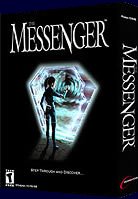|

The Messenger
|
Review by Ugur Sener
|
Developed by Index+, France Telecom Multimedia, and Canal+, The Messenger, once again puts players in charge of nothing less than saving the world. Members of an order known as the Black Templars have apparently created four artifacts of tremendous power, known as Satanís Keys, to avenge the destruction of their order and the slaughter of its members. If brought together, Satanís Keys will unleash their power, kindly destroying the world in the process. Naturally, it is up to the players, in the role of secret agent Morgan Sinclair, to go back in time to find and destroy these artifacts before the Black Templars can bring them together.
|

|
The Messenger starts with Morgan finding out about the keys through a message left by her late father. She then breaks into the Louvre Museum in France, where one of the artifacts is located. Once inside, Morgan encounters the ghost of a knight, who sends her back in time to Louvre in the middle ages, to find all of the artifacts and bring them to the present so they can be destroyed. Thus, Morgan embarks on a mysterious journey in search of Satanís Keys, overlooking the fact that the moment she has possession of all four of the artifacts, the world should be destroyed. Although the plot is obviously lacking in depth, The Messenger does offer the entertaining premise of exploring Louvre at different points in its history.
|

|
Each time period Morgan visits is like a small adventure game, with its own story and challenges. It is interesting to observe Louvre change through the ages, especially in terms of the people who occupy it. What is a glorious palace in one period degenerates into a hideout for prostitutes in another. The graphics of the game, although not groundbreaking, are still pleasant to look at and portray the palace and its inhabitants very nicely. The same can not be said for Morganís character animation however, since her face is unfortunately devoid of any emotion.
The sound effects have been very successfully handled both in terms of their timing and appropriateness for the occasion. The music is very nice, but it only plays on the menu screen and during the video sequences of the game. The voice acting is also generally acceptable, but the characters tend to speak rather unnaturally fast. It is almost as if the developers were consciously trying to keep the dialogue sequences short. Players should be warned however, as highly offending sexist jokes are abundant in the game.
|

|
The gameplay consists of exploring 3D images from Morganís point of view. The mouse pointer changes to indicate when Morgan can walk towards a direction, interact with a hotspot, or examine an object more closely. A right click grants access to the inventory screen, in which players can examine, combine or select items to use on hotspots. The only problem with this otherwise effective inventory system is that for no apparent reason, Morgan can only carry a certain number of items at a time. It doesnít matter how big or heavy the items in Morganís possession are; it only matters that she has no more than a certain number of them. Like in Resident Evil games, extra items need to be stored in magically connected chests found around the palace, forcing players to spend more time with puzzles than is necessary. As if to alleviate the annoyingness of the inventory problem, there is a very useful map function that can be accessed through the inventory screen. With a click on the map, Morgan can be transported directly a room she has already visited. Yet another feature is the Dictaphone that gives historical information about Louvre, which is not needed to beat the game, but might be interesting for some players.
|

|
The major flaw of the game is that all of the puzzle solving is essentially based on pixel hunting. Players keen on beating the game without getting any help must be willing to spend hours looking for hotspots that can be at very illogical places. The least interesting looking object in an area can be the only important one. Furthermore, hotspots are only available from certain points. That is, you could be virtually equidistant from a point of interest on two screens, and be able to interact with it only on one of them. Once the items of interest are located however, the puzzles can be solved relatively easily as they are simple and the clues to help the player are very clear.
|

|
Overall, The Messenger is an entertaining game with its flaws. It is a pleasant experience to observe the evolution of the palace through time. The interface is intuitive and smooth. The graphics, sound effects and music generally meet expectations. However, the game suffers greatly from the pixel hunting and the cumbersome inventory system. With more obvious and logical hotspots, an unlimited inventory, and perhaps a little more challenging puzzles The Messenger could have been a great game.
As it is, it deserves no more than 80/100.
Developer: Wanadoo
Publisher: Dreamcatcher
Genre: Adventure
Release Date: 2000
Platform: PC-MAC
System Requirements:
PC
Windows 95/98/ME/XP
32 MB RAM
64 MB Virtual Memory
Pentium 166 MHz (200 recommended)
16 Mb RAM (32 recommended)
4 x CD-ROM (8 x Recommended)
Mac
System 8.5.1
32 MB Available RAM (64 MB virtual)
6 MB 3D Video Card Open GL Compatible
8 x CD-ROM (8 x Recommended)
|
| *This article originally appeared on Just Adventure. |
|
|
|